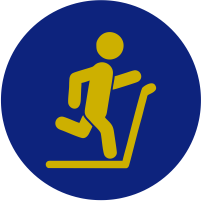Myofacial Pain
What Is Myofacial Pain?
Myofascial pain syndrome is a chronic pain disorder. In this condition, pressure on sensitive points in your muscles (trigger points) causes pain in the muscle and sometimes in seemingly unrelated parts of your body. This is called referred pain.
This syndrome typically occurs after a muscle has been contracted repetitively. This can be caused by repetitive motions used in jobs or hobbies or by stress-related muscle tension.
While nearly everyone has experienced muscle tension pain, the discomfort associated with myofascial pain syndrome persists or worsens. Treatment options include physical therapy and trigger point injections. Pain medications and relaxation techniques also can help.
What Causes Myofacial Pain?
This syndrome typically occurs after a muscle has been contracted repetitively. This can be caused by repetitive motions used in jobs or hobbies or by stress-related muscle tension.
What Are The Symptoms of Myofacial Pain?
Signs and symptoms of myofascial pain syndrome may include:
- Deep, aching pain in a muscle
- Pain that persists or worsens
- A tender knot in a muscle
- Difficulty sleeping due to pain
What Are The Treatment Options For Achilles Tendon Rupture or Tendinitis?
Treatment for myofascial pain syndrome typically includes medications, trigger point injections or physical therapy. No conclusive evidence supports using one therapy over another, but exercise is considered an important component of any treatment program. Discuss your options and treatment preferences with your doctor. You may need to try more than one approach to find pain relief.
Medications
Medications used for myofascial pain syndrome include:
- Pain relievers. Over-the-counter pain relievers such as ibuprofen (Advil, Motrin IB, others) and naproxen sodium (Aleve) may help some people. Or your doctor may prescribe stronger pain relievers. Some are available in patches that you place on your skin.
- Antidepressants. Many types of antidepressants can help relieve pain. For some people with myofascial pain syndrome, amitriptyline appears to reduce pain and improve sleep.
- Sedatives. Clonazepam (Klonopin) helps treat the anxiety and poor sleep that sometimes occur with myofascial pain syndrome. It must be used carefully because it can cause sleepiness and can be habit-forming.
Therapy
A physical therapist can devise a plan to help relieve your pain based on your signs and symptoms. Physical therapy to relieve myofascial pain syndrome may involve:
- Stretching. A physical therapist may lead you through gentle stretching exercises to help ease the pain in your affected muscle. If you feel trigger point pain when stretching, the physical therapist may spray a numbing solution on your skin.
- Posture training. Improving your posture can help relieve myofascial pain, particularly in your neck. Exercises that strengthen the muscles surrounding your trigger point will help you avoid overworking any one muscle.
- Massage. A physical therapist may massage your affected muscle to help relieve your pain. The physical therapist may use long hand strokes along your muscle or place pressure on specific areas of your muscle to release tension.
- Heat. Applying heat, via a hot pack or a hot shower, can help relieve muscle tension and reduce pain.
- Ultrasound. This type of therapy uses sound waves to increase blood circulation and warmth, which may promote healing in muscles affected by myofascial pain syndrome.
Our team is here for you
We offer the best, least invasive and least aggressive options to relieve your pain and symptoms so you can get back to the life you love. Atlantic Orthopaedic Specialists Pain Management Care Center has convenient locations in Virginia Beach, Norfolk and Chesapeake.



